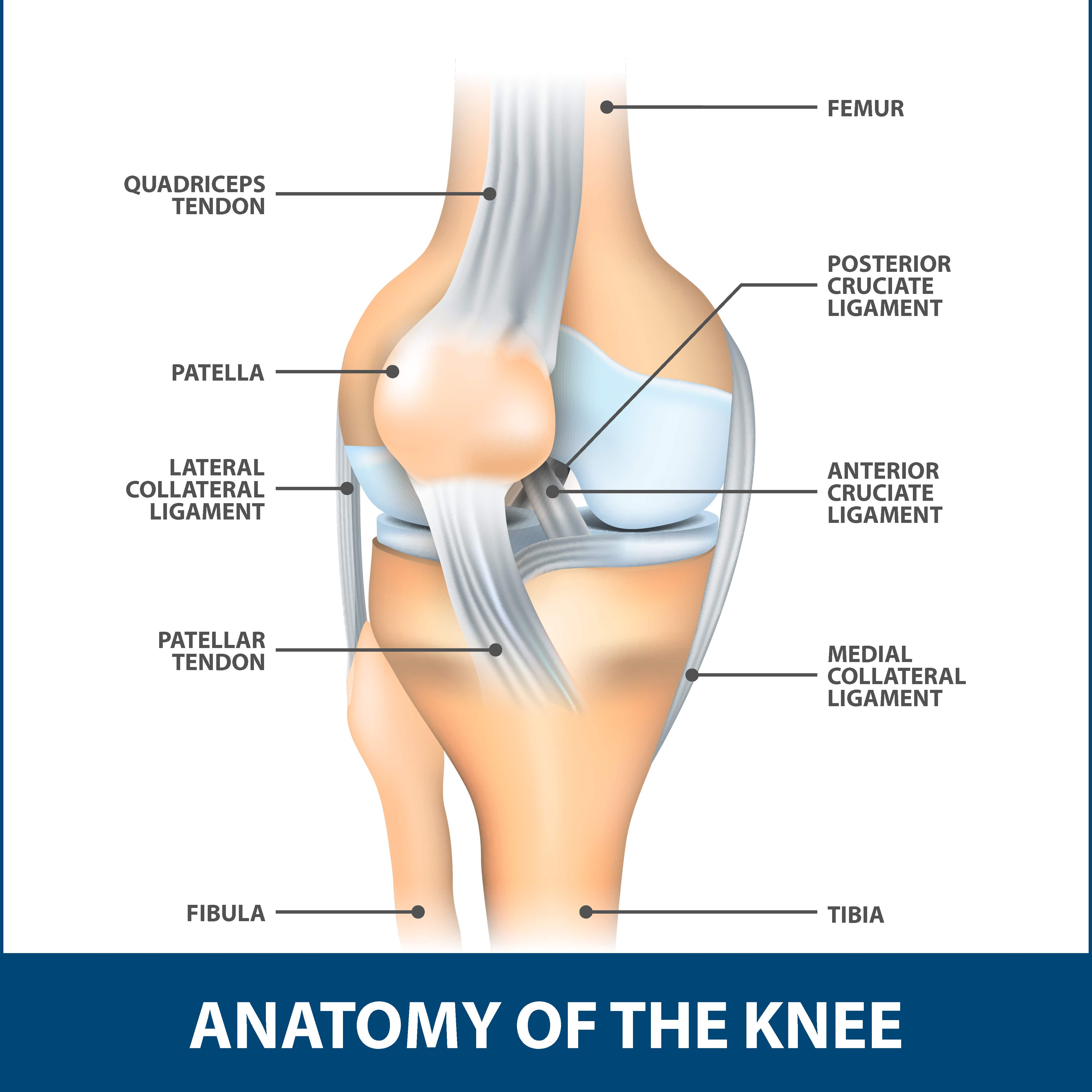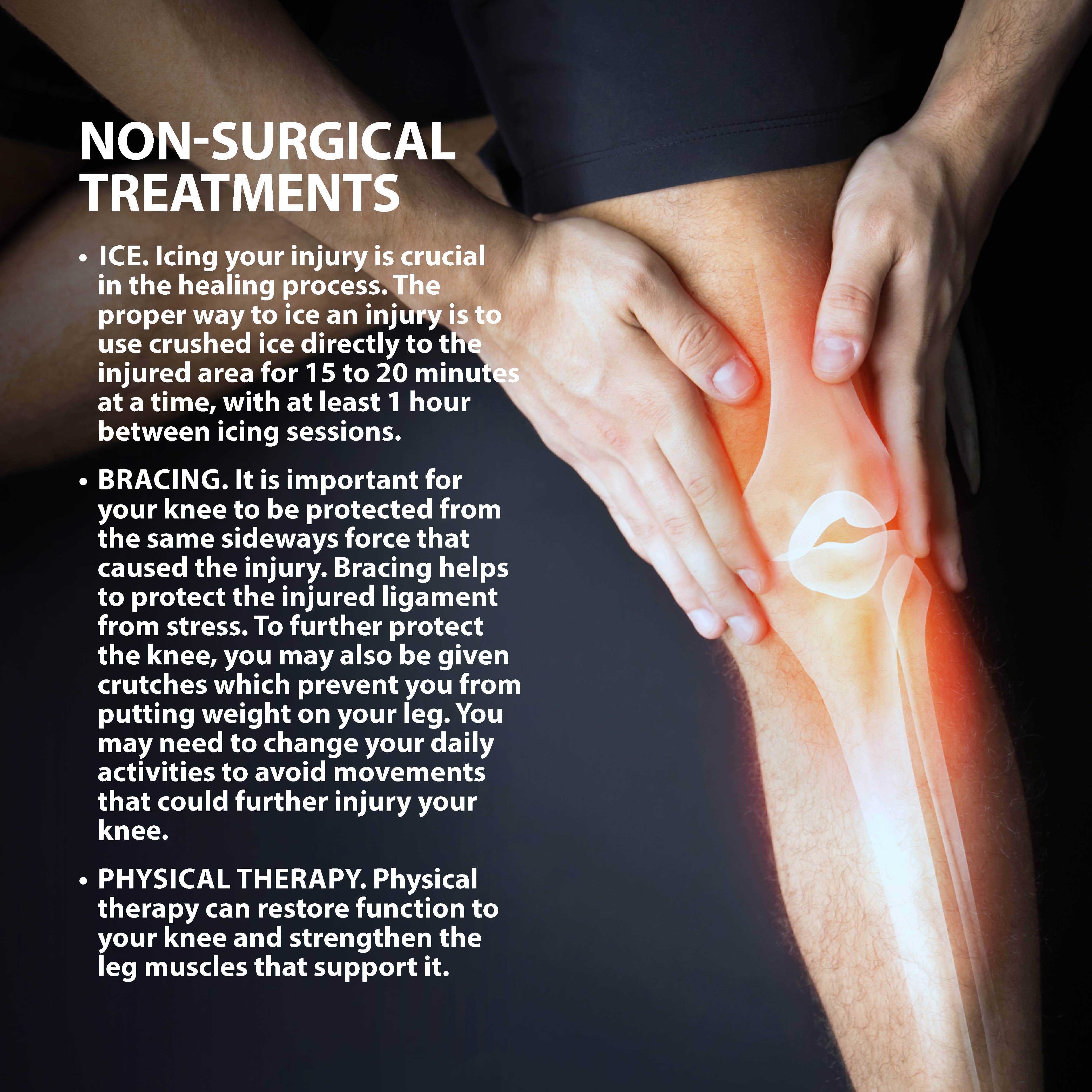Lateral Collateral Ligament (LCL) Injuries
Overview
A lateral collateral ligament, or LCL injury happens when the ligament located in the knee joint is injured. Ligaments are thick, strong bands of tissue that connect bone to bone, which helps to keep the knee joint stable. A lateral collateral ligament injury does not have to be completely torn. It can also be strained, sprained, or partially torn. There are both surgical and nonsurgical treatments available to help heal your ligament injury. Nonsurgical treatments are the main way to treat the injury. But if the injury is severe, then surgery may be necessary.
Anatomy
Three bones meet to form your knee joint: your thighbone (femur), shinbone (tibia), and kneecap (patella). Your kneecap sits in front of the joint to provide protection.
Bones are connected with ligaments. There are four primary ligaments in your knee. They act like strong ropes to hold the bones together and keep your knee stable. The lateral collateral ligament (LCL) runs along the outside of the knee joint, from the outside of the bottom of the femur to the top of the fibula. The LCL helps keep the knee joint stable, especially the outside of the joint.

Description
A lateral collateral ligament injury is when the ligament located in the knee joint is injured. Since the knee relies solely on the surrounding ligaments and muscles for stability, it can be easily injured. Any direct contact to the knee or hard muscle contraction, such as changing direction rapidly while running, can injure a knee ligament.
An injury to a lateral collateral ligament may include straining, spraining, and partially or completely tearing any part of the ligament. The leading cause of lateral collateral ligament injuries is from a direct-force trauma to the inside of the knee, causing the knee to be pushed outward. This puts pressure on the outside of the knee and causes the ligament to stretch or tear.
Symptoms
There are several symptoms associated with lateral collateral ligament injury, including:
- Pain on the outside of the knee.
- Swelling over and around the area of the injury.
- Knee instability and weakness.
Diagnosis
Your Florida Orthopaedic Institute physician will take a look at your symptoms and overall medical history, followed by a physical examination. During the exam, your physician will look at your injured knee and compare it with your non-injured knee. Most ligament injuries are diagnosed through a physical exam. Sometimes imaging tests may be needed to confirm the diagnosis. These tests include:
- MAGNETIC RESONANCE IMAGING (MRI) SCANS. This test creates images of soft tissues like the collateral ligaments. If your lateral collateral ligament is torn, this test will show it.
- X-RAYS. While x-rays will not show any injury to your collateral ligaments, they can identify if you also have a broken bone.
Treatment Overview
There are both surgical and non-surgical treatments available to help get you back on your feet. Non-surgical treatments are the main way to treat lateral collateral ligament injuries. But if the injury is unable to heal, then your physician may recommend surgical procedures.

Nonsurgical Treatments
Icing, bracing, and physical therapy are the three main nonsurgical options that your Florida Orthopaedic Institute physician can recommend. Typically, non-surgical treatments are recommended first unless your symptoms are severe and need immediate surgical procedures.
- ICE. Icing your injury is crucial to the healing process. The proper way to ice an injury is to use crushed ice directly to the injured area for 15 to 20 minutes at a time, with at least 1 hour between icing sessions.
- BRACING. It is important for your knee to be protected from the same sideways force that caused the injury. Bracing helps protect the injured ligament from stress. To further protect the knee, you may also be given crutches which helps from putting weight on your leg. You may need to change your daily activities to avoid movements that could further injure your knee.
- PHYSICAL THERAPY. Physical therapy can restore function to your knee and strengthen the leg muscles that support it.
Surgical Treatments
Most lateral collateral ligament injuries can be treated successfully without any surgical treatments. But if the torn ligament is unable to heal or is associated with other ligament injuries, your Florida Orthopaedic Institute physician may suggest a surgical procedure to fix it.
Next Steps
Contact your Florida Orthopaedic Institute physician to learn more about lateral collateral ligament injury.
Areas of Focus
- Knee & Leg
- ACL Injuries
- Arthroscopic Chondroplasty
- Articular Cartilage Restoration
- Deep Thigh Bruising
- Fractures Of The Tibial Spine
- Iliotibial Band Syndrome
- Lateral Collateral Ligament (LCL) Injuries
- MACI
- Medial Collateral Ligament Injuries
- Meniscus Tears
- Muscle Spasms
- Muscle Strains of The Calf
- Partial Knee Replacement
- Patellar Fracture
- Quadriceps Tendon Tear
- Runner's Knee
- Senior Strong
- Shin Splints
- Total Knee Replacement Surgery
The following Florida Orthopaedic Institute physicians specialize in Lateral Collateral Ligament (LCL) Injuries:
Specialties
- AC Joint Injuries
- Achilles Tendinitis - Achilles Insertional Calcific Tendinopathy (ACIT)
- Achilles Tendon Rupture
- Achilles Tendonitis
- ACL Injuries
- Ankle Fracture Surgery
- Ankle Fractures (Broken Ankle)
- Ankle Fusion Surgery
- Anterior Cervical Corpectomy & Discectomy
- Arthroscopic Articular Cartilage Repair
- Arthroscopic Chondroplasty
- Arthroscopic Debridement of the Elbow
- Arthroscopy Of the Ankle
- Articular Cartilage Restoration
- Artificial Disk Replacement (ADR)
- Aspiration of the Olecranon Bursa - Fluid In Elbow
- Atraumatic Shoulder Instability
- Avascular Necrosis (Osteonecrosis)
- Bankart Repair
- Basal Joint Surgery
- Bicep Tendon Tear
- Bicep Tenodesis
- Bone Cement Injection
- Bone Growth Stimulation
- Bone Health Clinic
- Broken Collarbone
- Bunions
- Bursitis of the Shoulder (Subacromial Bursitis)
- Calcific Tendinitis of the Shoulder
- Carpal Tunnel Syndrome
- Charcot Joint
- Chiropractic
- Clavicle Fractures
- Colles’ Fractures (Broken Wrist)
- Common Foot Fractures in Athletes
- Community Outreach
- Cubital Tunnel Syndrome
- De Quervain's Tenosynovitis
- Deep Thigh Bruising
- Degenerative Disk Disease
- Diffuse Idiopathic Skeletal Hyperostosis (DISH)
- Discectomy
- Discitis Treatment & Information
- Dislocated Shoulder
- Dupuytren’s Disease
- Elbow
- Elbow Bursitis
- Elbow Injuries & Inner Elbow Pain in Throwing Athletes
- Epidural Injections for Spinal Pain
- Finger Dislocation
- Flexor Tendonitis
- Foot Stress Fractures
- Foot, Ankle & Lower Leg
- Foraminotomy
- Fractured Fingers
- Fractures Of The Shoulder Blade (Scapula)
- Fractures Of The Tibial Spine
- Functional Nerve Transfers of The Hand
- Ganglion Cysts
- General Orthopedics
- Glenoid Labrum Tear
- Golfer's Elbow
- Groin Strains and Pulls
- Growth Plate Injuries Of The Elbow
- Hallux Rigidus Surgery - Cheilectomy
- Hammer Toe
- Hamstring Injuries
- Hand & Finger Replantation
- Hand & Wrist
- Hand Nerve Decompression
- Hand Skin Grafts
- Hand, Wrist, Elbow & Shoulder
- Heat Injury/Heat Prostration
- High Ankle Sprain (Syndesmosis Ligament Injury)
- Hip & Thigh
- Hip Arthroscopy
- Hip Dislocation
- Hip Flexor Strains
- Hip Fractures
- Hip Hemiarthroplasty
- Hip Impingement Labral Tears
- Hip Muscle Strains
- Hip Pointers and Trochanteric Bursitis
- Hyperextension Injury of the Elbow
- Iliopsoas Tenotomy
- Iliotibial Band Syndrome
- Impingement Syndrome of the Shoulder
- Interlaminar Implants
- Interlaminar Lumbar Instrumental Fusion: ILIF
- Interventional Pain Management
- Interventional Spine
- Intraarticular Calcaneal Fracture
- Joint Replacement
- Knee & Leg
- Kyphoplasty (Balloon Vertebroplasty)
- Kyphosis
- Labral Tears Of The Hip (Acetabular Labrum Tears)
- Laminectomy: Decompression Surgery
- Lateral Collateral Ligament (LCL) Injuries
- Lisfranc Injuries
- Little League Shoulder
- LITTLE LEAGUER'S ELBOW (MEDIAL APOPHYSITIS)
- Lumbar Epidural Steroid Injection
- Lumbar Interbody Fusion (IBF)
- MACI
- Mallet, Hammer & Claw Toes
- Medial Collateral Ligament Injuries
- Meniscus Tears
- Metatarsalgia
- Minimally Invasive Spine Surgery
- Morton’s Neuroma
- Muscle Spasms
- Muscle Strains of The Calf
- Nerve Pain
- Neuromas (Foot)
- Neurosurgery
- Olecranon Stress Fractures
- Orthopaedic Total Wellness
- Orthopaedic Trauma
- Orthopedic Physician Or A Podiatrist? Definition of a Podiatrist
- Osteoarthritis of the Hip
- Osteoporosis
- Outpatient Spine Surgery
- Partial Knee Replacement
- Patellar Fracture
- Pelvic Ring Fractures
- Peripheral Nerve Surgery (Hand) Revision
- Pinched Nerve
- Piriformis Syndrome
- Piriformis Syndrome
- Plantar Fasciitis
- Plastic Surgery
- Podiatry
- Primary Care Sports Medicine
- Quadriceps Tendon Tear
- Radial Tunnel Syndrome (Entrapment of the Radial Nerve)
- Revascularization of the Hand
- Reverse Total Shoulder Replacement
- Rheumatoid Arthritis (RA) of the Shoulder
- Rheumatoid Arthritis Of The Hand
- Robotics
- Rotator Cuff Tears
- Runner's Knee
- Sacroiliac Joint Pain
- Sciatica
- Scoliosis
- Senior Strong
- Shin Splints
- Shoulder
- Shoulder Arthritis
- Shoulder Arthroscopy
- Shoulder Injury: Pain In The Overhead Athlete
- Shoulder Replacement
- Shoulder Separations
- Shoulder Socket Fracture (Glenoid Fracture)
- SLAP Tears & Repairs
- Spinal Fusion
- Spine
- Spondylolisthesis and Spondylolysis
- Sports Foot Injuries
- Sports Hernias (Athletic Pubalgia)
- Sports Medicine
- Sports Wrist and Hand Injuries
- Sprained Ankle
- Sprained Wrist Symptoms and Treatment
- Subacromial Decompression
- Sudden (Acute) Finger, Hand & Wrist Injuries
- Targeted Muscle Reinnervation (TMR)
- Tendon Transfers of The Hand
- Tennis Elbow Treatment
- Thigh Fractures
- Thigh Muscle Strains
- Thumb Ulnar Collateral Ligament Injuries
- Total Ankle Replacement
- Total Hip Arthroplasty
- Total Hip Replacement - Anterior Approach
- Total Knee Replacement Surgery
- Trapezius Strain (Muscle Strain of The Upper Back)
- Traumatic Shoulder Instability
- Tricep Pain & Tendonitis
- Trigger Finger
- Turf Toe
- UCL (Ulnar Collateral Ligament) Injuries
- Ulnar Neuritis
- Valgus Extension Overload
- Vertebroplasty
- WALANT (Wide Awake Local Anesthesia No Tourniquet)
- Whiplash and Whiplash Associated Disorder (WAD)
- Wound Care
- Wrist Arthroscopy
- Wrist Fractures
- Wrist Tendonitis
Services
- Physical Medicine & Rehabilitation
- Physical Therapy
- Primary Care Sports Medicine
- PROMs (Patient-Reported Outcome Measures)
- Same-Day Orthopaedic Appointments Now Available
- Sports Medicine
- Sports-Related Concussion Treatment
- Telehealth Page
- Telemedicine
- Workers' Compensation
- Workers' Compensation Dispensary
- X-Ray
